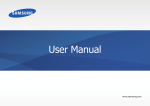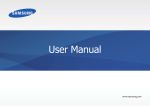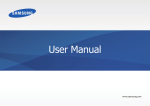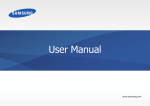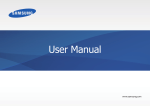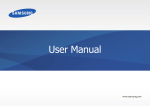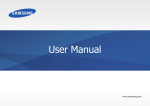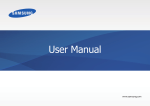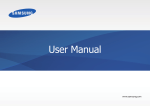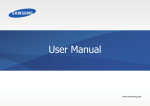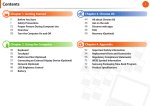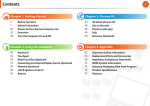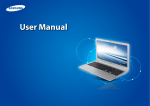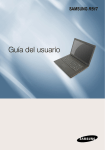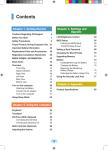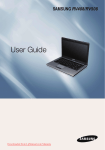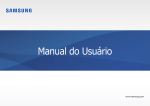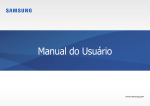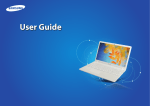Download User Manual - B&H Photo Video Digital Cameras, Photography
Transcript
User Manual www.samsung.com About this manual • This user manual describes procedures for using the touchpad and mouse. Instructions for using the touch screen are for models with the touch screen feature. • This user manual is specially designed to detail the computer’s functions and features. • Images and screenshots are those of the representative model of the series and may differ in appearance from the actual product. • The user manual supplied with the computer may vary depending on the model. • Content may differ from the final product and is subject to change without prior notice. For the latest version of the manual, refer to the Samsung website, www.samsung.com. • Please read this manual before using the computer to ensure safe and proper use. • Optional items, some devices and software referred to in the user manual may not be provided or subject to upgrades. Note that the computer environment referred in the user manual may not be the same as your environment. • Descriptions are based on the computer’s default settings and Windows 8.1 operating system. Available features and additional services may vary by computer or operating system. 2 About this manual Instructional icons and expressions Copyright © 2014 Samsung Electronics Co., Ltd. This manual is protected under international copyright laws. Warning: situations that could cause injury to yourself or others No part of this manual may be reproduced, distributed, translated, or transmitted in any form or by any means, electronic or mechanical, including photocopying, recording, or storing in any information storage and retrieval system, without the prior written permission of Samsung Electronics. Caution: situations that could cause damage to the computer or other equipment Note: notes, usage tips, or additional information Computer specifications or the contents of this manual may be changed without prior notice due to an upgrade of the computer’s functions. The order of options or menus you must select to perform a step. For example, select the Settings charm → Power (represents select the Settings charm and then Power). Select Click or touch. For example, when using a mouse or touchpad, select Settings means click Settings. When using a touch screen, it means touch Settings. 3 About this manual Trademarks HDMI, the HDMI logo, and the term High Definition Multimedia Interface are trademarks or registered trademarks of HDMI Licensing LLC. • Samsung and the Samsung logo are trademarks or registered trademarks of Samsung Electronics. • Intel and Core are trademarks or registered trademarks of the Intel Corporation. As an ENERGY STAR® Partner, Samsung has determined that this product meets the ENERGY STAR® guidelines for energy efficiency. • Microsoft, MS-DOS, and Windows are trademarks or registered trademarks of the Microsoft Corporation. • Bluetooth® is a registered trademark of Bluetooth SIG, Inc. worldwide. • The ENERGY STAR Program has reduced greenhouse gas emissions and saved energy through voluntary labeling. • Power management setting of this product have been enabled by default, and have various timing settings from 1 minute to 5 hours. • Wi-Fi®, Wi-Fi Protected Setup™, Wi-Fi Direct™, Wi-Fi CERTIFIED™, and the Wi-Fi logo are registered trademarks of the Wi-Fi Alliance. • The product can wake with a button press on the chassis from sleep mode. • All other trademarks and copyrights are the property of their respective owners. 4 About this manual Caution for the data Product capacity representation Samsung Electronics shall not be liable for any data loss. Please take care to avoid losing any important data and back up your data to prevent any such data loss. Storage capacity representation The capacity of the storage device (HDD, SSD) of the manufacturer is calculated assuming that 1KB=1,000 Bytes. Operating system and software support However, the operating system (Windows) calculates the storage device capacity assuming that 1KB=1,024 Bytes, and therefore the capacity representation of the HDD in Windows is smaller than the actual capacity due to the difference in capacity calculation. For example, for an 80GB HDD, Windows represents the capacity as 74.5GB, 80x1,000x1,000x1,000 byte/(1,024x1,024x1,024)byte = 74.505GB. If you change the product’s factory OS (Operating System) to another OS or if you install software which is not supported by the product’s original factory OS, you will not receive any technical support, product exchange or refund, and a fee will be charged when requesting a service. In addition, the capacity representation in Windows may be even smaller because some programs such as Recovery may reside in a hidden area of the HDD. Please use your computer with the original factory OS. If you install an OS other than the factory OS, data may be deleted or the computer may not start. Memory capacity representation Recommended screen resolutions The memory capacity reported in Windows is less than the actual capacity of memory. This is because BIOS or a video adapter uses a portion of memory or claims it for further use. For example, for 1GB(=1,024MB) memory installed, Windows may report the capacity as 1,022MB or less. The recommended screen resolution for Windows is “FHD” (1,920x1,080) and for Windows 8.1 is “QHD+” (3,200x1,800). If you set the resolution higher than the recommended value, it may result in problems with some applications, due to limitations of the operating system. 5 Table of contents Getting started 7Layout 12 Turning the computer on and off 14 Unlocking the screen 15Windows Basics 16 Using a wired keyboard/ mouse (Optional) 18 Using a wireless keyboard/ mouse (Optional) 26 LCD brightness 28Volume 29 Using the product as a monitor (Optional) 30 Playing music from smartphones directly through the computer speakers (Optional) 33 Using the TV (Optional) 37 Using the Remote Control (Optional) 40 Setup utility (BIOS) Network & Internet 45 Wired LAN 48 Wireless LAN External devices Appendix 59 Memory card 62 External display 63 Using the Security Slot 75 76 80 93 Troubleshooting 96 64Recover/Backup 70 Windows recovery function 70Q&A Applications 51 52 53 54 55 Using applications Settings Software Update Support Center ATIV Help (Self-help application solutions) 56 Quick Starter 56 Samsung Link (Optional) 6 98 115 117 Product specifications Ergonomic tips Safety precautions Important safety information Replacement parts and accessories Regulatory compliance statements WEEE symbol information Samsung package Take-Back program Getting started Front view 1 2 Layout 3 • Features or options may differ depending on the model. 4 • The items marked as optional may not be provided or may be provided in different locations. 5 6 7 Getting started Number/Name Camera indicator light Camera Remote Control Sensor (Optional) LCD Description • This indicates the camera operating status. • Using this camera, you can take still pictures and record video. Number/Name Control buttons (for corresponding models only) • You can take a picture or make a movie using the Charms → Start → Camera. • If a user presses a button on the remote control, the sensor detects the signal from the remote control and the computer performs the corresponding action. Power Button/ Power LED Stand Description • You can adjust various functions by pressing the control buttons at the botton of the monitor. • Turns the computer on and off. • When the computer is on, the power LED is lit. • This is the stand supporting the computer. • Do not place your hand between the stand and the back of the monitor. It may result in a hand injury. • To change the angle of the display, hold the display’s edges and adjust it to the desired angle. When using the remote control, take care not to block the sensor. If the sensor is blocked, the remote control will not function. • The screen images are displayed here. • Do not apply downward force to the product when it is placed face down. It may damage the LCD. 8 Getting started Control buttons (for corresponding models only) Number/Name Volume Control Use the buttons at the bottom of the monitor to control various functions. Bluetooth (Optional) 2 • Adjust the volume. • Switches between the PC mode and the monitor mode. Mode Selection 1 Description 3 9 • PC mode: the computer operates normally as a computer. • Monitor mode: the computer functions as a monitor. • Activate or deactivate Bluetooth pairing. Getting started Rear view Number/Name Microphone 1 Security Slot USB 2.0 Port USB 3.0 Port 2 3 7 5 4 8 or Chargeable USB 3.0 Port (Optional) 6 9 10 Description • You can use the built-in microphone. • You can secure the computer by connecting a lock and cable to the Security Slot. • This port is used as a USB port or chargeable USB port. • Using a chargeable USB 3.0 port, you can access or charge a USB device. You can tell the ports apart using the figures printed on the or ports or by the colors ( ). • U SB port • C hargeable USB 3.0 Port Getting started Number/Name HDMI input port HDMI output port Ear-set / headset Jack Description • Used to connect an HDMI cable from an external device. Number/Name DC Jack • Connect an HDMI cable to the HDMI output port of an external device to display the digital source (video/voice) from the device on the computer screen. • Used to connect an HDMI cable to an external device. Wired LAN Port TV Antenna Input Port • Connect an HDMI cable to the HDMI input port of an external device to display the digital source (voice/ video) on the external device. (Optional) Memory card slot • This is the jack for connecting an earset or headset. Description • A jack to connect the AC adapter that supplies power to the computer. • The appearance and size of the jack may differ depending on the model. • Connect the Ethernet cable to this port. • You can watch TV by connecting the antenna cable. Only for models with a TV tuner card. The shape of the port may differ depending on the country. • Insert a memory card into the slot. About the chargeable USB 3.0 port • It may take longer to charge the battery when charging a USB device. • The charging status of the USB device is not displayed on the computer. • This feature may not be available with some USB devices. 11 Getting started Turning the computer on and off About Windows Activation When you turn the computer on for the first time, the Windows activation screen appears. Turning on Follow the activation procedures according to the instructions on the screen to use the computer. 1 Connect the AC adapter. If there is no display but a message of “HDMI” on the screen after you turn on the computer, press the button to change the picture mode. (monitor mode → PC mode) 3 1 2 2 Press the Power button to turn the computer on. Power LED is lit while the computer is turned on. Power LED 12 Getting started Turning off Turning off on the Start screen Turning off on the desktop 1 Select Power ( ) at the upper-right corner of the Start screen. 1 To select the Start button, do one of the following: • Mouse: Right-click the Start button ( ) at the lower-left edge of the desktop. 2 Select Shut down or sign out → Shut down. Start • Save all the data before turning off the computer. • Since the procedures to turn the computer off may differ depending on the installed operating system, please turn the computer off according to the procedures for the purchased operating system. 2 Select Shut down. 13 Getting started Unlocking the screen Turning off on the Charms 1 To open the Charms, do one of the following: To unlock the lock screen, do one of the following: • Mouse: Click the lock screen. • Touchpad/Mouse: Move the cursor to the upper- or lowerright edge of the screen. Start • Keyboard: Press any key. • Touchpad: Tap the touchpad. Start 2 Select the Settings charm → Power → Shut down. 10:00 Wednesday, January 1 If the account has a password, enter the password to log in after unlocking the screen. 14 Getting started Windows Help+Tips On the Start screen, select Help+Tips. Microsoft Windows is an operating system that is used to control a computer. For optimal use of the computer, learn how to use the operating system properly. It is best to learn how to use Windows by using Windows Help and Support, and Help+Tips. Start • Images and available features may differ depending on the model and operating system. • This manual is designed for Windows 8.1 and content may differ depending on the OS version. • The image displayed on the desktop screen may differ between models and OS versions. You can control Windows menus with the mouse or with gestures. Help To access the help, do one of the following: • Keyboard: Press the F1 key. • Mouse: Move the cursor to the upper- or lower-right edge of the screen to open the Charms and select the Settings charm → Help. 15 Basics Using a wired keyboard/mouse (Optional) Use the keyboard to enter characters and perform various functions. Special keys Delete or insert text, move the cursor to the beginning or the end of the line, or scroll up or down the page. Function keys Performs specific software functions. The functions may differ depending on the program. Indicator light Indicates if the Num Lock, Caps Lock, and Scroll Lock keys are activated. Number keys The numeric keypad can be used when the Num Lock key is pressed. Windows Key The Start screen appears. Directional keys Moves the cursor up, down, left or right. 16 Basics Click function A mouse is a device that controls the cursor or pointer on the screen. Briefly press the left mouse button once. The appearance and the color of the provided mouse may differ depending on the model. If you click this mouse button once, the corresponding program is selected. Wheel button Moves the pointer up and down. Double-click function Right button Shows the context-sensitive menus of programs. Quickly press the left mouse button twice. The corresponding program is launched. Left button Selects and launches an item. Right click function If you click this mouse button once, the context-sensitive menu of the current program appears. If you move the mouse, the pointer on the screen moves in the same direction. 17 Basics Using a wireless keyboard/mouse (Optional) Drag function Dragging refers to clicking an item and moving the item to another position while holding the mouse button down. The wireless keyboard and mouse are optional and the appearance and the color of the provided keyboard and mouse may differ depending on the model. Click the left mouse button over an item to be dragged and move the item to the new position while holding the mouse button down. Installing the wireless receiver 1 Open the Battery Cover at the bottom and insert the battery Scroll function in the right polarity (+,-). If you turn the wheel button up or down, the screen moves up or down accordingly. Example) Wireless mouse CONNECT button Press the connect button to activate the wireless receiver. Battery Cover Power switch If you set this switch to the OFF position when not using the mouse, you can save battery power. 18 Wireless signal receiver Basics 2 Insert the wireless signal receiver into the USB port at the 3 Slide the power switch at the bottom of the mouse to the ON back of the computer. position. Example) Wireless mouse 4 You can use the wireless keyboard and the mouse without additional settings. • You can use the wireless keyboard and the wireless mouse within a 5m distance of the wireless signal sensor. • The distance is subject to the surroundings and if there is interference nearby, in particular a wireless LAN AP, the distance may be decreased. 19 Basics 2 Insert the batteries and then close the battery cover. Wireless keyboard 1 Locate the battery cover at the bottom back of the keyboard. 1 Use your fingers to push the cover up. 2 Battery cover 2 1 • Be sure to confirm that the polarities (+ / -) of the batteries are correct. • Do not recharge the batteries (AAA type) supplied with the product. 20 Basics Battery replacement LED This indicates when it is time to replace the battery. If the LED blinks, replace the batteries. Directional keys Moves the cursor up, down, left or right. Windows Key The Start screen appears. Battery cover CONNECT button Press the connect button to connect to the wireless signal receiver. 21 Basics Shortcut Keys While pressing and holding the Fn key, press a shorcut keys. + Shortcut Keys Shortcut keys Function Description F1 Play the previous file F2 Play/Pause F3 Stop F4 Play the next file F5 Search F6 Share F7 Device Each menu item will be activated as appropriate. F8 Setup * This is not available on Windows 7. Shortcut keys F9 F10 Play the media file F11 F12 These are Windows menu keys. Function Description Mute Toggle the sound on and off. Volume control Adjust the volume. Power saving mode Switch to power saving mode. The wireless keyboard automatically enters power-saving mode if there is no key input for a pre-determined period of time. Press any key to resume using the keyboard in power-saving mode. However, a function to turn the keyboard off is not supported. 22 Basics Wireless Mouse Double-click function Quickly press the left mouse button twice. Wheel button Moves the pointer up and down. The corresponding program is launched. Right button Shows the contextsensitive menus of programs. Right click function If you click this mouse button once, the context-sensitive menu of the current program appears. Left button Selects and launches an item. Drag function Dragging refers to clicking an item and moving the item to another position while holding the mouse button down. Click the left mouse button over an item to be dragged and move the item to the new position while holding the mouse button down. If you move the mouse, the pointer on the screen moves in the same direction. Scroll function If you turn the wheel button up or down, the screen moves up or down accordingly. Click function Briefly press the left mouse button once. If you click this mouse button once, the corresponding program is selected. 23 Basics 2 Within 30 seconds of reconnecting the receiver, press and If the wireless keyboard does not work hold the CONNECT button for 1 seconds near the receiver. ► Check if it is out of battery. For the keyboard, check if the battery low indicator top right blinks. at the If the indicator blinks, you need to replace the battery. ► Check the status of the wireless signal receiver. CONNECT button 1 Disconnect the wireless receiver from the main body and then reconnect it. 3 Check if the device works properly. 24 Basics 2 Disconnect and then reconnect the wireless signal receiver to If the wireless mouse does not work the main body. ►W hen the power switch at the bottom of the mouse is in the OFF position, the mouse does not work. Turn the switch to the ON position. ► Check if it is out of battery. ► Check the status of the wireless signal receiver. 1 Set the power switch at the bottom of the mouse to the OFF position. 3 Set the power switch at the bottom of the mouse to the ON position. 25 Basics 4 Within 30 seconds of reconnecting the receiver, press and LCD brightness hold the CONNECT button for 1 seconds near the receiver. 5 Adjust the LCD brightness to reduce eye strain and save power. Check if the device works properly. Controlling with Charms Open the Charms, select the Settings charm → slider. 26 , and drag the Basics Samsung Computer’s Defective LCD pixel management standard Changing display mode Set the optimal conditions for the screen, based on the activity. Although Samsung Electronics, Co., Ltd. observes strict quality and confidence specifications for LCD manufacturing, the company must inevitably allow a few defective cells in panels due to a technological limitation of the manufacturing process. 1 On the Start screen, select . 2 Select Settings. 3 Select Display → Display Color → an option. Therefore Samsung observes and manages the following dot principles: • Adapt Display: Optimizes the screen automatically for the currently running program. • Bright dot : 2 or less • Black dot : 4 or less • Standard: Appropriate for normal environments and convenient for most situations. • Combination of Bright and Dark : 4 or less • Photo Editing: Appropriate for editing photos. Instructions for Cleaning the LCD • Reading mode: Appropriate for reading documents. Clean the LCD panel with a soft cloth lightly moistened with computer cleansing detergent moving in one direction. Cleaning the LCD panel with excessive force can damage the LCD. 27 Basics Volume Controlling with Charms Open the Charms, select the Settings charm → slider. Adjust the system volume or sound volume when playing music or video. Using the control button Press the button to control the volume. 28 , and drag the Basics Using the product as a monitor (Optional) Dolby Digital Plus Use Dolby Digital Plus to optimize your audio experience. This feature enhances sound elements by analyzing and adjusting sound levels automatically. The LCD screen of this product can be used as a monitor using the Digital Video/Audio Input Port (HDMI-IN). This feature may not be available depending on the model and operating system. Try using this product as a monitor by connecting an HDMI device such as a computer, gaming console, DVD player and so on. 1 On the desktop, open the Charms and select the Settings Using the product as a monitor charm → Control Panel → Hardware and Sound → Dolby . Digital Plus Home Theater 2 Click 1 Connect the external device (HDMI output port) and this and select a play mode. product (digital video/audio input port (HDMI-IN)) with the HDMI cable. Movie, music, game, and voice optimization modes are provided by default, and you can add custom modes. 2 Press the mode. 29 button to switch this product to monitor Basics Playing music from smartphones directly through the computer speakers (Optional) You can only use monitor mode by connecting the Digital Video/Audio Input Port (HDMI-IN). The Digital Video/Audio Out Port (HDMI-OUT) is for output only. • As long as the power cord is connected, you can use the LCD of the product as a monitor even when the product is off. Use Bluetooth pairing to play music from smartphones or tablets (hereinafter “smartphones”) through the computer speakers. • Even if the product is switched to monitor mode by button during an operation, the pressing the operating system is not terminated. Press the button again to return to PC mode. Pair the smartphone to the computer, and quickly access music. • This is available only with Bluetooth-compliant smartphones. • If the product is switched to monitor mode, the audio is also switched accordingly. • Keep a certain distance from the computer. • The screen and user interface depend on the model and driver version. • If no picture is displayed on the LCD screen when the product is switched to monitor mode, disconnect and then reconnect the HDMI port. Pairing the computer to the smartphone • To use the computer in the monitor mode after the computer enters the power saving mode or shuts down, press the LCD On/Off button. Pair the computer to the smartphone for the initial settings. 1 Press the Bluetooth button on the computer. The indicator blinks with a message of Pairing on the screen. Returning to PC mode To regain pairing, press and hold the button for 3 seconds or more. To return to PC mode from monitor mode, press the button. 30 Basics 3 You will see Connected on the computer screen. Bluetooth Music Play Pairing Bluetooth Music Play Connected Pairing is complete. 2 Select a music file on the smartphone, and listen to the music through the computer speakers. On the smartphone, activate Bluetooth and select Bluetooth Music Play to proceed. ex) Pairing on Samsung smartphones: From Settings, select and activate Bluetooth, and then tap Bluetooth Music Play to proceed. 31 Basics Using the computer speakers Turning off the computer speakers Once pairing is established, press the Bluetooth button for quick access. Press the Bluetooth button to turn off the indicator. 1 Press the Bluetooth button A message of Off appears in the lower right corner. The computer speakers are now turned off. on the computer to turn on the indicator. • If no music is output through the computer speakers, check if the smartphone is paired to the computer properly. If pairing is disconnected, refer to Pairing the computer to the smartphone and regain paring. The computer speakers turn on with a message of Ready in the lower right corner. 2 Move the smartphone close to the computer to automatically • In case of disconnected pairing, present the smart phone close to the computer to regain pairing. pair the two devices. When pairing is complete, Connected appears on the screen. • The volume is not controlled by the volume buttons on the computer. To control the volume, adjust the volume on the smartphone. Bluetooth Music Play Connected 3 You can now listen to music through the computer speakers. Select a music file to play on the smartphone. 32 Basics Using the TV (Optional) Configuring the TV • The screenshots and terms used in the user manual may differ from the actual ones. Products embedded with a TV tuner card (Optional) can use the TV function. • The screen and menu titles of the TV program (ATIV TV) may differ depending on the version. After connecting to the antenna, you can watch TV by using the corresponding TV program. You can only use the TV function when the TV tuner card (Optional) is installed. 1 Click Start Screen → TV programs (ATIV TV). 2 Click Start on the main screen. Connecting the TV Antenna The built-in TV tuner starts scanning channels available. You must connect the TV tuner card (Optional) to the TV antenna. Connect the antenna cable to the TV antenna input port. 3 When the auto scanning is complete, the default TV channel will be run. Resetting the channels In the lower right corner of the smartphone, select Menu → Settings → Reset TV Signal. The scanned channels are saved. Note on Configuration • The setup procedures may differ depending on the current type of your TV service. • The area must be set to the country of your current residence. 33 Basics TV Program Menu Exit Maximize Minimize Menu Description Channel List Displays the list of channels available. EPG (Electronic Program Guide) Recorded TV Channel List Recorded TV EPG (Electronic Program Guide) 34 This is a TV program guide covering all digital TV channels. EPG will extract the program schedule information contained in the digital TV signal. However, it may differ depending on the corresponding station and the reception. Also, some functions may not be provided. You can watch a recorded TV program. Basics Watching TV Recording TV 1 Start the TV program (ATIV TV). 2 Click Channel List to switch to the channel. You can record a TV program on your computer. Recording the current program In the bottom right corner, select Menu now. → Record → Record This will start the recording. The recording time can be adjusted using the Timer menu in the bottom right corner. Select the asterisk next to the channel title, and then click the channel list to display a list of those channels that contain the asterisk . 35 Basics Playing a recorded program Creating a recording schedule 1 In the bottom right corner, select Menu Click Recorded TV. → Record → The recorded programs are displayed. Select a program to watch. Reserved Recording. You can list the recorded programs by program, channel or date. 2 Set your program and the reservation time. • Even when the computer is in power-saving (sleep) mode, if the recording reservation time is reached, the TV automatically wakes up from power-saving mode and performs the reserved recording. When the computer is in hibernation mode, recording reservations will not work. • While recording a channel, you cannot record or watch another channel. • The recording file will be saved to File Explorer → Local disk (C:) → User → User Folder → Video. • Sizes of recorded TV programs range from several gigabytes to tens of gigabytes. • Recorded TV programs can be played only by the ATIV TV app on the computer where the recording took place. 36 Basics Using the Remote Control (Optional) Installing the batteries Open the cover at the bottom of the remote control and insert the batteries according to the correct polarities (+, -). You can use the TV functions with the remote control. You can run the Live TV program from the desktop. Check the functions of each button. • The appearance of the remote control may differ from the actual one. Some functions may not be provided depending on the system. • Use your remote control by pointing it toward the remote control receiver. • If the remote control does not operate at all, replace it with a new one. 37 Basics Launches Internet Explorer Sleep Mode Release standby mode (reactivate Windows) or turn on the computer This button is not supported on some computers. Mute Channel Controls Volume Controls Play Controls Stop Record Play / Pause Tab key TV or Spacebar function (optional): You can run the TV program from the desktop. Back ODD Eject Windows Key Select Go Switch Application Close Windows Hot keys: Launch a program or website from an assigned shortcut button. To assign a shortcut button to a program or website, select Settings → Input → Setting the Remote Control. Windows Settings Windows Device Windows Search Windows Share • Some buttons on the remote control may function differently depending on the operating system. • The Search, Share, Device, and Settings buttons are not available on Windows 7. 38 Basics TV mode/PC mode The remote control is available in both TV mode and PC mode. Available only in PC mode • TV mode: TV mode will be activated by opening the TV program on desktop. – – To open the TV program, press the TV button. Available only in TV mode – – To exit the TV program, press the Close button. • PC mode: In PC mode, you can use the computer as you would do normally. The remote control’s buttons are available only in specific modes, and some of the buttons may not function depending on the option. TV button Available in both PC mode/ TV mode Available only in PC mode Available in both PC mode/ TV mode Close button Exit the TV program. 39 Basics Setup utility (BIOS) Learning the BIOS screen The BIOS setup screen appears as shown below. Define a boot password, change the boot priority, or configure the installed chipsets. • Incorrect settings may cause the system to malfunction or crash. System Time > System Date > • The BIOS setup screens, menus, and items may appear differently depending on the model and BIOS version. SATA Port 1 XXXX CPU CPU CPU CPU XXXX XXXX XXXX XXXX • BIOS setup functions are subject to upgrades. BIOS Version XXXX MICOM Version XXXX Vender Type Core Speed VT (VT-x) Total Memory Entering the BIOS screen XXXX 3 American Megatrends, Inc. Aptio Setup Utility - Copy (C) 2012 1 Turn on the computer. 2 Before the Samsung logo (Samsung ATIV) appears, press the F2 key several times. • If the computer is password-protected, press the F2 key several times before the password screen appears. • If the password screen or the Windows start screen appears, restart the computer and try again. 40 Basics Number BIOS setup keys Name • Setup items Key • Setup tools – – Help: View the help for BIOS set up. – – Default: Return to default settings. – – Restore: Cancel changes. Description / • Change values. / • Move to another menu. Enter • Select an item or enter a sub-menu. Space • Help F1 • Change the slide button. • Return to a higher level menu or to the Exit menu. • View the setup help. • Setup menu F3 • Load the previous settings. F9 • Load the default settings. F10 • Save changes and exit the BIOS setup. – – Save: Save settings. Esc – – Exit: Exit BIOS setup. – – SysInfo: View the basic specifications of the computer. – – Advanced: Configure the chipsets and additional functions. – – Security: Configure security functions. – – Boot: Configure peripherals and boot-related settings. • The BIOS setup screen appears only in English. • When using a keyboard, only certain keys will control the BIOS setup screen. 41 Basics Boot password Setting passwords Setting a password with the BIOS enhances protection against viruses and hacking attacks. There are three password settings available; Supervisor Password, User Password, and HDD Password. • Supervisor Password (low security level): This password is required when turning on the computer or attempt to enter the BIOS setup. • Do not forget your password or expose it to others. • If you forget the Supervisor Password or HDD Password, request assistance from the service center. In this case, a service fee will be charged. • User Password (low security level): This password is required to enter the BIOS setup. This password will be deactivated automatically if the Supervisor Password is disabled. • When you forget the User Password, disable the Supervisor Password, and the User Password is also automatically disabled. • HDD Password (high security level): This password is required to access the hard disk drive (HDD) from another computer. This password may not be supported, depending on the model. 42 Basics 6 Enter the password again to confirm it and select Ok. 7 Select Save → Yes to save and restart. Setting a boot password 1 Turn on the computer. 2 Before the Samsung logo appears, press the F2 key several • To enable the Password on boot option, set a Supervisor Password and enter the password when starting up the computer. times. 3 Access the Security menu. 4 Select a password type (Supervisor Password, User • To change the HDD Password after setting it, restart the computer. • For some models, when the password entered message appears in the Setup Notice window, select Ok to complete the setup. Password, or HDD Password). If you cannot select an item or the HDD Password Frozen message appears, restart the computer. Then, press the F2 key several times before the Samsung logo appears to enter the BIOS setup screen. 5 Enter a password and select Ok. The password can be up to 20 characters. 43 Basics Removing a password Boot priority 1 Turn on the computer. 2 Before the Samsung logo appears, press the F2 key several Change the boot priority from the BIOS setup. 1 Turn on the computer. 2 Before the Samsung logo appears, press the F2 key several times. times. 3 Access the Security menu. 4 Select a password type (Supervisor Password, User 3 Access the Boot menu. 4 Select Boot Device Priority. 5 Click an option menu to open the list. 6 Select an option. 7 Select Save → Yes to save and restart. Password, or HDD Password). 5 Enter the current password and select Ok. 6 Without entering any characters, select Ok → Ok. For some models, to cancel the password, select Cancel in the Setup Notice window. Select Exit → Yes to restart without saving the changes. To boot to DOS when using a bootable USB device, enter the BIOS setup. Then, select the Boot menu, and set the Fast BIOS Mode item to Off. 44 Network & Internet Wired LAN 1 Connect a LAN cable to the LAN port on the computer. Wired LAN To access the Internet at home, set up an account with an Internet service provider (ISP). To purchase Internet service and a modem, contact a local ISP. • Some features or procedures may differ depending on the model. • These descriptions are written for Windows 8.1, so some figures and descriptions may differ from your operating system. Since the procedures for other Windows operating systems are similar, use the computer referring to these descriptions. 45 Network & Internet 2 On the desktop, open the Charms and select the Settings 4 Select Internet Protocol Version 4 (TCP/IPv4) from the list of charm → Control Panel → Network and Internet → Network and Sharing Center → Change adapter settings. network settings → Properties. • The Network Component name may differ depending on the operating system Installed. 3 Right-click Ethernet and select Properties. The LAN device name may differ depending on the computer’s network device. • To add a network item such as a client, service, or protocol, select Install under the list of network items. 46 Network & Internet 5 Configure the IP settings. Wake on LAN (WOL) feature • When using DHCP, select Obtain an IP address automatically. Activate the system remotely from sleep mode when a signal, such as a magic packet command, is received via a wired LAN. • When not using DHCP, contact the network administrator for the IP address. To use a static IP address, select Use the following IP address and set the IP address manually. 1 On the desktop, open the Charms and select the Settings charm → Control Panel → Network and Internet → Network and Sharing Center → Change adapter settings. 6 Select OK to save the settings. 2 Right-click Ethernet and select Properties. 3 Select Configure… → Power Management → Allow this device to wake the computer → OK. 4 Restart the computer. • If the computer wakes up from sleep mode inadvertently, disable the Wake on LAN feature. • This feature may not work while using other power saving features. To disable other sleep functions, select the Settings charm → Control Panel → Hardware and Sound and then set Power Options. 47 Network & Internet • When connected to a 100Mbps/1Gbps wired LAN , a message appears informing the user of connection to a 10Mbps/100Mbps wired LAN when the computer wakes from sleep mode. This happens because restoring the network takes about 3 seconds. When the network is restored, the computer will be connected to the 100Mbps/1Gbps LAN. Wireless LAN Connect the computer to a wireless network to use the Internet. The descriptions below are for computer models with a Wireless LAN card or device. A Wireless LAN device is optional. The pictures in this manual may differ from the actual product depending on the wireless LAN device model. • When the system is running on battery power, it may take a few seconds for the connection to be established when connecting a LAN cable. This is the result of power saving features designed to reduce battery consumption. About Access Point (AP) An Access Point (AP) is a network device that bridges wired and wireless LANs and corresponds to a wireless hub in a wired network. Multiple devices can be connected to an AP. • When the system is running on battery power, the speed of a wired LAN is decreased automatically to reduce battery consumption. In this case, a 1Gbps/100Mbps LAN would function at the speed of a 100Mbps/10Mbps connection. 48 Network & Internet 2 Select a network from the list of detected wireless networks Wi-Fi networks 1 Open the Charms and then select Settings charm → → Connect automatically → Connect. . Networks Networks View Connection Settings View Connection Settings Airplane mode Off Airplane mode Off Wi-Fi Wi-Fi On On AP List Connect automatically Connect 3 Enter a password, if necessary, and select Next. Once the computer has been connected to a wireless network, it will attempt to connect to it automatically when it is available. For the network key, please ask the network administrator. 49 Network & Internet Airplane mode Airplane mode disables all wireless functions on the computer. Only non-network services are available in Airplane mode. To turn on Airplane mode, open the Charms and select the Settings charm → , and then select the Airplane mode switch. 50 Applications • Some applications are available only in Windows 8.1 desktop mode. Using applications • Third-party software related services For descriptions about and service requests for third-party applications, please contact the relevant manufacturer. Some troubleshooting actions in response to service requests may not work depending on the application manufacturer. • Images and features may differ depending on the model and the application version. Applications include the software that make up the operating system. Windows provides basic applications for frequently-performed tasks. • Applications that are provided by Samsung can be installed from SW Update. • Some applications may not be supported depending on the model. 51 Applications Settings Settings, a Samsung integrated settings application, offers various settings functions. Images and features may differ depending on the model and the application version. 1 On the Start screen, click at the lower-left edge, and select Settings. 2 Select an option to configure the corresponding function. Menu Description General • Set general settings. System Optimization • Set system optimization settings. Power Management • Set power related settings. Network • Set network functions and settings. Display • Set the screen brightness and color. Audio • Set sound effect settings. • Assign shortcut buttons on the remote control to launch programs or websites. • Set security functions and settings. Input Privacy Protection 52 Applications Software Update 2 Read and agree to the User Agreement. Install and update Samsung applications and drivers on the computer easily and conveniently. This application enables the user to search for or download the BIOS, drivers, and applications over the Internet. Keep the computer performing better and more stably with SW Update. 3 Select Install & Update. This step appears only when the application runs for the first time. • To check for available updates, the computer must be connected to the Internet. • Only applications that have been installed with this application can be updated. • Images and features may differ depending on the model and the application version. 1 On the Start screen, click at the lower-left edge, and select SW Update. 4 Select items to update → OK. 53 Applications Support Center 1 On the Start screen, click Diagnose the performance, security, and status of the computer and fix any problems it may have. Additionally, access the FAQ and search features to find solutions for the problems. 2 Select Resolve to correct the problems. at the lower-left edge, and select Support Center. • The Support Center application may not be provided or may be a different version depending on the model. • Images and features may differ depending on the model and the application version. 54 Applications ATIV Help (Self-help application solutions) Using ATIV Help 1 On a smartphone, tap ATIV Help. 2 On the ATIV HELP main screen, select the desired menu. Use ATIV Help to access help-related content for Samsung computers from a smartphone. Watch the ATIV Help videos to become familiar with new functions or to find solutions to problems. ATIV Help videos are available on Samsung Tomorrow’s YouTube page (http://www.youtube.com/samsungnotebook). Installing ATIV Help 1 On a smartphone, tap Play Store and search for ATIV Help. 2 Tap Install → Agree to complete the setup. 3 Select a menu and then a desired topic from the available content that appears. You may incur additional charges when you access content. 55 Applications Quick Starter Samsung Link (Optional) Use Quick Starter to easily launch frequently used software from the desktop. Samsung Link enables you to remotely view/move files between the computer and the smartphone/tablet (“smartphone”). • Quick Starter may not be available or the application version may differ depending on the model. Preparation • To enable this option, you must have a registered Samsung account. • The features and icon images may differ depending on the model. 1 On the taskbar, click Quick Starter ( 2 Quick starter launches. • This is available only when the computer is on. • Follow the instructions below: ). 1. Register the computer to Samsung Link. 2. Register the smartphone to Samsung Link. 3. Connect the two devices remotely. • This is available with Samsung smartphones. Menu Start menu Samsung Utilities • The screen and user interface depend on the model and driver version. Description • The start menu used in this device is similar to the start menu used in earlier versions of Windows 8.1. • Use the start menu to easily access various programs or settings, or to turn off the computer. • Launch software provided for Samsung computers. 56 Applications Registration Registering the smartphone to Samsung Link Registering the computer to Samsung Link 1 On the smartphone, select Settings → Account → Add 1 Click the bottom-left icon account, and provide the same account information that you have registered to Samsung Link. on the Start screen, and then click Samsung Link. 2 Run the Samsung Link app on the smartphone to connect the computer and the smartphone. 2 On the smartphone, provide your Samsung account information to log in. • To check the connection, select Samsung Link → Settings → Device Management on the computer. If you are not a registered user, simply click Create new account, and follow the onscreen instructions. • For Galaxy S5 and later, it is not necessary to install or to connect the computer and run Samsung Link the smartphone. You can view registered devices on the smartphone by selecting Video, Music, or Gallery → Devices. What is Samsung Account? Samsung Account is an integrated account service that allows users to log into and enjoy a variety of Samsung services on smartphones, tablets, websites, PCs, or on the TV with a single account. Specifying a share folder Specify a share folder for the content to share from the computer. On the computer, run Samsung Link and select Settings. Then, specify devices and a share folder for content sharing. 57 Applications 3 Take advantage of the content sharing function. Controlling the computer from the smartphone View, play, or upload/download the multimedia content between the computer and the smartphone. 1 Run the Samsung Link app on the smartphone. 2 Select the computer from the list, and then tap the power icon •U pload: Tap and hold an item on the smartphone, and then tap Send. Specify the computer from the list to start uploading. . Remote connection will be established. • Download: On the smartphone, tap and hold a content item from the computer, and then tap Send. Specify the smartphone from the list to start downloading. To discontinue the remote connection, select the power icon. computer from the list, and then tap the 58 External devices To use a mini or micro card, insert the card into an adapter before inserting it into the memory card slot. • Some memory cards may not be fully compatible with the computer. Using an incompatible card may damage the computer or the memory card, or corrupt the data stored in it. Memory card Use a memory card to transfer data to other devices, such as digital cameras or MP3 players. Memory cards are sold separately. Purchase a memory card with the necessary capacity for the requirement. • Use caution to insert the memory card in the indicated direction. This computer supports the following types of memory cards. • Memory card speeds vary. Abbreviation Description SD • Secure Digital mini SD • mini Secure Digital micro SD • micro Secure Digital SDHC • Secure Digital High Capacity mini SDHC • mini Secure Digital High Capacity micro SDHC • micro Secure Digital High Capacity SDXC • Secure Digital eXtended Capacity micro SDXC • micro Secure Digital eXtended Capacity • Store the card separately to prevent losing the card when moving the computer. 59 External devices 3 Select the pop-up message to open the memory card folder. Inserting a memory card If a pop-up message appears, click the corresponding window → Continue without scanning. 1 If a dummy card or a memory card adapter is inserted in the memory card slot, remove it. 4 Select Open folder to view files. 5 Save, move, or delete data on the memory card. 2 Insert a memory card into the memory card slot in the indicated direction. Use a memory card adapter to insert a micro memory card into the memory card slot. The memory card folder opens only on the desktop. Removing a memory card For mini memory cards, use a mini card adapter. A memory card adapter is an optional item and may not be provided with some models. Grasp the end of the card and pull it out of the slot. 60 External devices • To use a memory card to exchange data with a digital device, such as a digital camera, formatting the data with the digital device is recommended. Formatting a memory card Format the memory card to remove all data or before using it for the first time. • When trying to use a formatted memory card in another digital device, format the memory card again in the device. Formatting a memory card deletes all data saved on the card. If necessary, back up important data before formatting the card. • Inserting and removing a memory card repeatedly may damage the memory card. 1 On the taskbar, select File Explorer ( ). 2 Right-click the memory card drive, and then select Format. 3 Select Start. • Secure Digital Input Output (SDIO) is not supported. • If the write-protect tab is in the locked position, you cannot format, write, or delete data on the card. 61 External devices 2 Select Charms menu → Devices charm → Project → Second External display Screen. Connecting the computer to an external display device can be useful for presentations or when watching a movie. The cables required to connect an external display are sold separately. The computer supports HDMI cables. Select a desired monitor mode. PC screen only The contents are only displayed on the PC monitor (current device). Duplicate 1 Using an HDMI cable, connect the HDMI output port of the computer to the HDMI input port of the TV. The contents of the current device are displayed on the external device as well. • This is only supported for models that support a TV output port (HDMI). Extend • When a TV provides more than one HDMI port, connect the computer to the DVI IN port. The screen of the current device is expanded to the external device. Second screen only • When connecting the computer to a TV, switch the external input mode of the TV to HDMI. The contents are displayed only on the screen of the external device. External Monitor / TV is not supported in the DOS Command Prompt window. 62 External devices Using the Security Slot You can secure the computer by connecting a lock and cable to the Security Slot. To use this feature, you have to purchase the lock and cable additionally. To use the lock and cable, refer to the product manual. Tie the lock and cable to a fixed object and install the other end of the cable to the security slot. 1 2 63 Troubleshooting • The Recovery application may not be provided in models with less than 64 GB of memory. For models with less than 64 GB of memory, recover the computer to the factory default settings by reinstalling Windows. • Some functions may differ or may be unavailable, depending on the version. Refer to the application’s help for more information. Recover/Backup When a problem occurs with the computer, it is possible to easily recover the computer back to the factory default settings by using the Recovery application (Recover/Backup). It is also possible to recover the computer to a previously backed up point. Back up important data regularly before a problem occurs with the computer. • Run the Recovery application with administrator privileges. • CD/DVD drives are not supported by the Recovery application. • Recovering the computer erases the data or applications saved after a backup point. Therefore, back up important data regularly before a problem occurs with the computer. 64 Troubleshooting 2 Select Backup Management → Factory image → Recover. Recovering to factory default Recover the computer to factory default settings. If necessary, back up important data to an external storage device before restoring the system. See Backing up the current system. 1 When the computer starts Windows: On the Start screen, click at the lower-left edge, and select Recovery. When the computer does not start Windows: Turn on the computer and press the F4 key several times before the Samsung logo (Samsung ATIV) appears. 65 Troubleshooting 3 Select Recover. Backing up the current system Back up important data to an alternate internal drive or an external storage device regularly to prevent data loss. 1 Select Backup Management → Drag the Maintain user data switch to the right and select items to maintain while recovering the computer. 4 Follow the on-screen instructions to complete the recovery. 66 . Troubleshooting 2 Select a drive from the drive list → Backup. Recovering after a backup • When backing up to an external storage device, connect the device to the computer and then select the external drive. Select a backup point saved on an alternate internal drive or an external storage device to recover the computer to the point. 1 When backing up to an external storage device, connect the device to the computer. 2 On the Start screen, click Recovery. 3 Follow the on-screen instructions to complete the backup. 67 at the lower-left edge, and select Troubleshooting 3 Select Backup Management → a backup image → Recover. Copying the drive (making a disk image) To replace the drive, move the data to the new drive by making a disk image. The new drive must be large enough to hold the data from the current drive. Purchase an external hard drive connector separately to connect the new drive to the computer. 1 Connect the new drive to the computer with an external hard drive connector. 2 On the Start screen, click Recovery. 4 3 Select Disk copy. Follow the on-screen instructions to complete data recovery. 68 at the lower-left edge, and select Troubleshooting 5 After the data is saved to another drive, open the cover at the 4 Select a recovery point → Disk copy. bottom of the computer and replace the existing drive with the new one. The data on the disk is copied to the new disk. If the cover is difficult to open, contact the Samsung Service Center to request assistance. You will be charged for this service. 69 Troubleshooting Windows recovery function Q&A If the Recovery application is not supported by the computer, recover system to factory default settings using the recovery function of Windows. When experiencing problems with the computer, try these solutions. Windows Reinstalling Windows will erase all data saved on the computer. Back up application and personal data to an external storage device before reinstalling Windows. Where is the Shut down button? 1 Open the Charms and select the Settings charm → Change Mouse: PC settings → Update and recovery → Recovery. • At the upper-right corner of the Start screen, select Power ( ) → Shut down. 2 Select Get Started under Remove everything and reinstall • Open the Charms and select the Settings charm → Power → Shut down. Windows. Select Get Started under Refresh your PC without affecting your files to recover the computer while keeping photos, videos, music files, and documents. • Right-click the Start button, and then click Shut down or sign out → Shut down. 3 Follow the on-screen instructions to proceed with the reinstallation. After a recovery, on the Start screen, click at the lowerleft edge, and select SW Update to install the necessary Samsung applications. 70 Troubleshooting My application disappeared from the Start screen. How can I correct this? How can I uninstall an application? 1 On the desktop, open the Charms and select the Settings Mouse: 1 On the Start screen, click charm. 2 Select Control Panel → Programs → Uninstall a program → at the lower-left edge to view an application → Uninstall. installed applications. 2 Alternatively, right-click the Start button, and the select Programs and Features. Right-click an application, and then select Pin to start. Select an application to uninstall → uninstall. 71 Troubleshooting How can I change the screen settings, environment settings, color, and so on? How can I start my computer in DOS? Configure the lock screen, Start screen, and account picture by opening the Charms and selecting the Settings charm → Change PC settings → PC and devices. To configure any other features, on the desktop, open the Charms and select the Settings charm → Control Panel. 1 Turn on the computer. 2 Before the Samsung logo appears, press the F2 key several To start the computer in DOS via a USB device: times. 3 Select the Boot menu. 4 Set Fast BIOS Mode to Off. 5 Set Secure boot Control to Off. 6 Set OS Mode Selection to CSM mode and then restart the Why am I unable to run Active X in Internet Explorer when I launch it on the Start screen? The version of Internet Explorer that appears on the Start screen complies with HTML5 web standards, so it does not support Active X. Launch Internet Explorer on the desktop to view websites that require Active X. computer. Can I remove Windows 8 or Windows 8.1 and install a different operating system? To install a different operation system on the computer, change the BIOS settings first. For more information, visit http://www.samsung.com → Customer support → Troubleshooting and search for Windows 8 or Windows 8.1. 72 Troubleshooting Recovery Why is the capacity representation of the hard disk drive (HDD) in Windows different from the product specifications? What is a Recovery Area? The capacity of the storage device (HDD or SSD) of the manufacturer is calculated assuming that 1KB=1,000 Bytes. However, the operating system (Windows) calculates the storage device capacity assuming that 1KB=1,024 Bytes, and therefore the capacity representation of the HDD in Windows is smaller than the actual capacity. The capacity representation in Windows may be smaller than the actual capacity because some applications occupy a certain area of the HDD outside of Windows. The computer has an additional partition for restoring data or saving backup files (only for models with the Recovery application). This partition is called a Recovery Area and it includes a recovery image comprised of the operating system and applications. For models with the Recovery application, the HDD capacity representation in Windows may be smaller than the actual capacity because the Recovery application uses a hidden area of 5-20 GB of the HDD to save the recovery image, and that hidden area is not counted towards the total size available to Windows. The size of the Recovery application varies by model. 73 Troubleshooting Camera/Microphone What is a recovery image? This refers to specifications about the operating system, drivers, and software that are converted to a data image. It is required to recover the computer and is embedded in the computer’s HDD. However, this is not provided for storage devices where the capacity is less than 64 GB, due to their small capacities. The camera and the microphone are not working. How do I turn them on again? When the recording protect mode is activated, the camera and microphone will not work. To turn off the recording protect mode, hold down the Fn key and then press the F11 key. How can I recover a computer that does not have the Recovery application? Recover the computer with the recovery function provided by Windows. Refer to the Recover Functionality item in the help for more details. 74 Appendix Item AC/DC rating PC rating Product specifications The system specifications may differ depending on the derived models. For detailed system specifications, refer to the product catalogue. Item CPU • SATA3 HDD / SSD Graphics Operating environment • The Storage device capacity of a computer in which Recovery is installed, is represented as smaller than the product specification. • Intel Core i5 Processor Storage device • Output: 19 VDC 4.74 A, 19 VDC 3.16 A • 19 VDC 3.16 A (60 W), 19 VDC 4.74 A (90 W) • The system specifications are subject to change without notice. • Intel Pentium DualCore Processor • Memory type: L PDDR3 • Input: 100–240 VAC, 50–60 Hz • Optional components may not be provided or different components may be provided depending on the model. Specification Main memory Specification • Replacement, addition, or upgrade of memory is unavailable for this computer hardware. To replace or upgrade the memory and to replace the storage device, contact the Samsung Service Center. • Intel HD4600 (i5) / HD Graphics (Pentium) • Temperature: - 5–40 °C for storage, 10–35 °C when operating • The amount of memory that Windows can use may be smaller than the actual amount of memory available. • Humidity: 5 –90 % for storage, 20–80 % when operating 75 Appendix Ergonomic tips • Use an adjustable chair with firm, comfortable support. • Adjust the height of your chair so that thighs are horizontal to the floor and feet are flat on the floor. Maintaining a proper posture during computer use is very important to prevent physical injury. Improper or prolonged keyboard use may result in repetitive strain injury. Viewing the monitor screen for extended periods of time may result in eye strain. Therefore, please follow these guidelines carefully when setting up and using the computer. • The back of the chair should support the lower back. Adjust the backrest to fit your body properly. • Sit back fully in your chair and straighten the back and neck. Avoid leaning forward or craning your neck toward the computer screen. • Avoid using the computer while lying down or on your lap. If the computer’s temperature increases, there is a danger of burn injury. Back and neck • The instructions in this manual have been prepared so that they can be applied to the range of needs of general users. If the user is not included in the range, the recommendations should be applied according to the user’s needs. • Images may differ from actual products. 76 Appendix Arms and hands • When using the keyboard and touchpad, the shoulders should be relaxed. The upper arm and forearm should form an angle that is slightly greater than a right angle, with the wrist and hand in almost a straight line. • Use a light touch when typing or using the touchpad and keep the hands and fingers relaxed. Avoid rolling the thumbs under your palms or supporting the wrists on the desk while typing. • Use an external keyboard and mouse when using the computer for long periods. When using an external keyboard and mouse, position the devices at the same height as the computer and within comfortable reach. 77 Appendix Eye position and display illumination Hearing and volume control cm 50 VOLUME Check your volume! • Ensure that volume is not too loud before using headphones. • Position the screen at least 50 cm away from your eyes. • Avoid using headphones for long periods of time. • Adjust the height of the screen so that its top edge is equal to or just below the level of your eyes. • Default audio settings can be changed by software and driver updates without your knowledge. Always recheck equalizer and volume settings before listening to audio. • Avoid setting the screen’s brightness settings excessively high. • To prevent possible hearing damage, do not listen at high volume levels for long periods. • Keep the screen clean. • If wearing glasses, clean them before using the computer. • When referring to printed content while typing, use a static paper holder to hold the paper at about the same height as the monitor. 78 Appendix Operating conditions • Take at least a 10 minute break every hour. • Avoid using the computer in dark locations. Use the computer with as much ambient light as you would when reading a book. • Indirect illumination is recommended. Use a curtain to prevent reflections and glare on the screen. • While operating a computer and talking on the phone, use a headset. Using the computer while holding a phone on your shoulder or with your neck may lead to muscle strain or injury. • Keep frequently used items within reach. • Use the computer only within the temperature and humidity ranges specified in this manual. 79 Appendix Safety precautions Warning This safety information relates to computer use. Some of the content may be not applicable to your computer. To prevent injury or damage to your computer, read the safety information before using it. Failure to follow instructions marked with this symbol may cause personal injury and even fatality. Installation related • Since this is commonly applied to Samsung Computers, some pictures may differ from actual products. Keep the computer at least 15 cm away from any object. • The term “product,” as used in this manual, refers to basic components, such as the computer, battery, adapter and optional accessories provided by Samsung. 15cm Failure to do so may result in computer malfunction or injury. Do not place or use the computer on slanted or vibrating places. Failure to do so may result in computer malfunction or damage. To avoid danger of suffocation, keep the plastic bag away from infants and children. Putting a plastic bag over the head may result in suffocation. NP v3.7 80 Appendix Connect the power cord to the AC adapter firmly. Power related The power plug and wall outlet figures may differ depending on the country specifications and the product model. Otherwise, there is a danger of fire due to an incomplete contact. Use only the AC adapter supplied with the product. Handle the power cord with care. • Do not touch with wet hands. Using another adapter may cause the screen to flicker. • Do not use a damaged or loose power cord. Use only properly earthed electric sockets or extension cords. • Use only specified voltage/capacity. • Firmly insert the power cable into the AC adapter. Connecting to unearthed electric sockets or extension cords does not protect users from earth faults. Unearthed electric sockets or extension cords may cause electric shock or fire. • Do not unplug the power cord by pulling the cable only. • Unplug the wall-mount AC adapter (adapter and plug integrated type) from the wall outlet while holding the body and pulling it. If water or another substance enters the product, disconnect the power cord and contact the Samsung Service Center. For notebook computers that are provided with an external removable battery, separate the battery also. Failure to do so may result in electric shock or fire. Damage to the device within the computer may cause electric shock or fire. 81 Appendix Take care not to allow metal objects such as a key or clip to touch the battery terminal (metal parts). Keep the power cord or outlet clean with a dry towel so that they are not covered with dust. Failure to do so may result in electric shock or fire. This may cause excessive current and result in fire, burns, or damage to the battery. Do not bend or damage the power cable or the AC adapter with a heavy or sharp-edged object. If the product leaks, emits strange odors, or swells, immediately stop using the product and contact the Samsung Service Center. A damaged cable or cord may result in electric shock or fire. Failure to do so may result in an explosion or fire. Battery usage related To use the computer safely, replace a dead battery with a new, authorized battery. Keep the battery, AC adapter, and the power cord away from infants and pets. Failure to do so may result in electric shock or computer malfunction. When removing the real time clock (RTC) battery, keep it away from infants and children. Use only Samsung-approved battery and AC adapter. If a child swallows the battery, the child may suffocate. If this happens, immediately contact a doctor. Batteries or AC adapters that are not approved by Samsung may malfunction from a defective safety device, resulting in an explosion or fire. 82 Appendix Never heat the product or put the product into a fire. Do not put or use the product in a hot location such as a sauna, inside a vehicle exposed to heat, and so on. Usage related Do not use the computer on heated floors or electric pads, or on beds, blankets, or cushions that block the ventilation of the computer. There is a danger of explosion or fire. In these environments, be careful not to block the vent of the computer, which is normally at the side or bottom of the computer. A blocked vent causes the computer to overheat, resulting in an explosion, fire, burns, or computer malfunction. Before cleaning the computer, disconnect all the cables that are connected to the computer. For notebook computers that are provided with an external removable battery, separate the battery also. Failure to do so may result in electric shock or fire. Do not use the computer in very damp locations such as a bathroom. Keep the product away from water or liquid. Failure to do so may result in computer malfunction or electric shock. Use the computer within the recommended temperature and humidity range (10–35 °C, 20–80 % RH). Water or liquid entering the computer may cause a short circuit inside the product, resulting in electric shock or fire. 83 Appendix If the product is dropped or broken, disconnect the power cord and contact the Samsung Service Center. For notebook computers that are provided with an external removable battery, separate the battery also. Follow all instructions as specified in the user manual. Do not disassemble any other parts by yourself. Failure to do so may result in computer malfunction, electric shock, or fire. Using a broken computer may result in electric shock or fire. Do not disassemble the power supply unit, the AC adapter, or the battery under any circumstances. Do not touch the computer vents or the connected AC adapter for extended periods while the computer is on. Failure to do so may result in electric shock, fire, or an explosion. Contact with the vent or the connected AC adapter for extended periods may result in lowtemperature burns, such as redness on the skin. Shut down the computer and disconnect all cables before disassembling the computer. If the notebook is an external and removable battery type, remove the external battery. Failure to do so, may cause electric shock. Upgrade related Do not attempt to upgrade the computer, unless you are qualified. Contact the Samsung Service Center or an electrician. 84 Appendix When carrying the notebook computer with other items, such as the adapter, mouse, books etc, take care not to press anything against the notebook computer. Storage and movement related Do not close the LCD panel and put the computer into a bag to move it when it is still turned on. If a heavy object is pressed against the notebook computer, a white spot or stain may appear on the LCD. Therefore, take care not to apply any pressure to the notebook. The computer may overheat and there is a danger of fire. Shut the computer down properly before moving it. In this case, place the notebook computer in a separate compartment away from the other objects. When using wireless communication (LAN, Bluetooth, etc) always follow applicable instructions. For example, airlines and hospitals have strict requirements. Avoid exposing a drive to magnetic fields. Security devices with magnetic fields include airport walk-through devices and security wands. The airport security devices that check carry-on luggage, such as conveyor belts, use x-rays instead of magnetism and will not damage a drive. 85 Appendix Do not place a heavy object over the product. Caution This may cause a problem with the computer. In addition, the object may fall and cause injury, or damage the computer. Failure to follow instructions marked with this symbol may cause slight injury or damage to the product. Connect the power cord to a nearer consent when installing the computer. Installation related If a problem occurs to the computer and disconnection from the consent is delayed, there is a danger of electric shock or fire. Do not block the ports (holes), vents, etc. of the product and do not insert objects. Dispose of worn-out batteries properly. Damage to a component within the computer may cause electric shock or fire. • There is a danger of fire or explosion. • The battery disposal method may differ depending on your country and region. Dispose of the used battery in an appropriate way. When using the computer with it lying on its side, place it so that the vents face upwards. Failure to do so, may cause the internal temperature of the computer to rise and the computer to malfunction or halt. Do not throw or disassemble the battery and do not put it into water. This may cause an injury, fire or explosion. 86 Appendix Use only a battery authorized by Samsung. Usage related Failure to do so may cause an explosion. Use the pen for its intended purpose only. Avoid contact with metal objects such as car keys or clips when keeping or carrying a battery. Using the pen improperly may cause physical injury. Do not place a candle, light cigar, etc. over or on the product. Contact with a metal may cause excessive current and a high temperature and may damage the battery or cause a fire. There is a danger of fire. Make sure to have the product tested by a safety service engineer after repairing the product. Charge the battery according to the instructions in the manual. Failure to do so, may cause an explosion or fire from damage to the product. Authorized Samsung Repair Centers will carry out safety checks after a repair. Using a repaired product without testing it for safety may cause an electric shock or fire. Do not heat the product(or battery) or expose it to heat (e.g. inside a vehicle during the summer). There is a danger of explosion or fire. 87 Appendix In case of lightning, immediately turn the system off, disconnect the power cord from the wall outlet and phone line from modem. Do not use a modem or phone. Do not drop, hit, or apply excessive force to the computer. There is a danger of electric shock or fire. Do not touch the antenna with electricity facility such as the power outlet. Connect only permitted devices to the connectors or ports of the computer. There is a danger of electric shock. Failure to do so, may cause electric shock and fire. When handling computer parts, follow the instructions on the manual supplied with the parts. Close the LCD panel only after checking if the notebook computer is turned off. Failure to do so, may cause damage to the product. The temperature may rise and it may cause deformation of the product. If the computer emits smoke, or there is a burning smell, disconnect the power plug from the wall outlet and contact the Samsung Service Center immediately. If the notebook is external, and removable battery type, remove the external battery. Failure to do so may result in physical injury or data loss. Do not press the Eject Button while the CD-ROM drive is in operation. There is a danger of fire. You might lose data and the disk might be suddenly ejected and could cause an injury. Do not use a damaged or modified CD. There is a danger of damaging the product or personal injury. 88 Appendix Keep the product away from magnetic fields. Do not insert the fingers into the PC Card Slot. There is a danger of injury or electric shock. • Magnetic materials may cause the product malfunction or cause the battery to discharge. Use recommended computer cleansing solution when cleaning the product and only use the computer when it is completely dried. • The magnetism in the computer may damage the information in the magnetic stripe cards such as credit cards. Failure to do so may cause electric shock or fire. Upgrade Related Emergency disk eject method using paperclip should not be used while the disk is in motion. Make sure to use the emergency disk eject method only when the Optical Disk Drive has stopped. Take care when touching the product or parts. The device may be damaged or you may be injured. Take care not to throw or drop a computer part or device. There is a danger of injury. This may cause injury or damage to the product. Do not place your face close to the Optical Disk Drive tray when it is operating. There is a danger of injury due to an abrupt ejection. 89 Appendix Make sure to close the computer cover before connecting the power after a reassembly. Storage and movement related There is a danger of electric shock if your body touches an internal part. Properly shut down, disconnect and secure the computer cables before moving it. Use parts authorized by Samsung only. Failure to do so may damage the computer or cause someone to trip over a loose cable. Failure to do so, may cause fire or damage the product. For long periods of not using the notebook computer, discharge the battery and preserve as it is detached. (For external and removable battery type) Never disassemble or repair the product by yourself. If the computer serviced or repaired by an unqualified technician, the warranty will not cover the repair fees. There is a danger of accident. Use authorized Samsung Service Centers. The battery will be preserved at its best condition. Do not operate or watch the computer while driving a vehicle. To connect a device that is not manufactured or authorized by Samsung, enquire at the Samsung Service Center before connecting the device. There is a danger of a traffic accident. Please concentrate on driving. There is a danger of damaging the product. 90 Appendix Cautions on preventing data loss (Hard disk management) Causes that may damage the data of a hard disk drive and the hard disk drive itself. Take care not to damage the data on a hard disk drive. • The data may be lost when an external impact is applied to the disk while disassembling or assembling the computer. • A hard disk drive is so sensitive to external impact that an external impact may cause loss of data on the surface of the disk. • The data may be lost when the computer is turned off or reset by a power failure while the hard disk drive is operating. • The data may be lost and irrecoverable due to a computer virus infection. • Take extra care, because moving the computer or an impact on the computer when it is turned on may damage the data of the hard disk drive. • The data may be lost if the power is turned off while running an application. • Samsung is not liable for any loss of data on the hard disk drive. • Sudden impact or movement to the computer while the hard disk drive is operating, may cause files to be corrupted or bad sectors on the hard disk. To prevent data loss due to damage to the hard disk drive, please back up the data frequently. 91 Appendix LCD bad pixels principle of the computer Cleaning the LCD screen Samsung observes strict specifications regarding the quality and reliability of the LCD. However, there is a small chance that a few pixels may be bad. A large number of bad pixels can cause problems with the display, but a small number of bad pixels does not generally affect computer performance. Clean the LCD screen with a soft cloth dampened with computer cleansing detergent. When cleaning the screen, move the cloth in one direction. Do not use excessive force. Doing so may damage the LCD screen. Samsung’s quality standards for bad pixels are as follows: • Bright dot: 2 or fewer • Black dot: 4 or fewer • Combination (bright and dark): 4 or fewer 92 Appendix Important safety information Setting up the system • Read and follow all instructions marked on the product and in the documentation before operating the system. Retain all safety and operating instructions for future use. Safety instructions The system is designed and tested to meet the latest standards for safety of information technology equipment. However, to ensure safe use of this product, it is important that the safety instructions marked on the product and in the documentation are followed. • Do not use this product near water or a heat source such as a radiator. • Set up the system on a stable work surface. • The product should be operated only with the type of power source indicated on the rating label. Always follow these instructions to help guard against personal injury and damage to the system. • Ensure that the electrical outlet to power the equipment is easily accessible in case of fire or short circuit. • If the computer has a voltage selector switch, make sure that the switch is in the proper position for your area. • Openings in the computer case are provided for ventilation. Do not block or cover these openings. Make sure you provide adequate space, at least 6 inches (15 cm), around the system for ventilation when setting up your work area. Never insert objects of any kind into the computer ventilation openings. 93 Appendix • Ensure that the fan vents on the bottom of the casing are clear at all times. Do not place the computer on a soft surface, doing so will block the bottom vents. Care during use • Do not walk on the power cord or allow anything to rest on it. • Do not spill anything on the system. The best way to avoid spills is to not eat or drink near the system. • When using an extension cord with this system, make sure that the total power rating on the products plugged into the extension cord does not exceed the extension cord power rating. • Some products have a replaceable CMOS battery on the system board. There is a danger of explosion if the CMOS battery is replaced incorrectly. Replace the battery with the same or equivalent type recommended by the manufacturer. • For Notebooks with glossy display bezels the user should consider the placement of the Notebook as the bezel may cause disturbing reflections from surrounding light and bright surfaces. Dispose of batteries according to the manufacturers instructions. If the CMOS battery requires replacement insure that a qualified technician performs the task. • When the computer is turned off, a small amount of electrical current still flows through the computer. To avoid electrical shock, always unplug all power cables, remove the battery and modem cables from the wall outlets before cleaning the system. 94 Appendix • Unplug the system from the wall outlet and refer servicing to qualified personnel if: The instruction on safety operation of the computer 1 When installing and operating devices please refer to safety – – The power cord or plug is damaged. requirements in the user manual. – – Liquid has been spilled into the system. – – The system does not operate properly when the operating instructions are followed. 2 Devices can be used only with the equipment specified in the – – The system was dropped or the casing is damaged. 3 If any smell of burning or smoke is detected from the technical specifications of the devices. – – The system performance changes. computer the unit should be switched off and battery removed. The unit should be checked by a qualified technician before reuse. 4 Service and repair of devices should be carried out by authorized service centers. 5 Do not allow the portable computer to operate with the base resting directly on exposed skin for extended periods of time. The surface temperature of the base will rise during normal operation (particularly when AC Power is present). Allowing sustained contact with exposed skin can cause discomfort or eventually a burn. 95 Appendix Replacement parts and accessories Battery disposal Do not put rechargeable batteries or products powered by non-removable rechargeable batteries in the garbage. Use only replacement parts and accessories recommended by manufacturer. Contact the Samsung Service Center for information on how to dispose of batteries that you cannot use or recharge any longer. Follow all local regulations when disposing of old batteries. To reduce the risk of fire, use only No. 26 AWG or larger telecommunications line cord. THERE IS RISK OF EXPLOSION IF BATTERY IS REPLACED BY AN INCORRECT TYPE. Do not use this product in areas classified as hazardous. Such areas include patient care areas of medical and dental facilities, oxygen rich environments, or industrial areas. DISPORE OF USED BATTERIES ACCORDING TO THE INSTRUCTIONS. 96 Appendix Laser safety Connect and disconnect the AC adapter All systems equipped with CD or DVD drives comply with the appropriate safety standards, including IEC 60825-1. The laser devices in these components are classified as “Class 1 Laser Products” under a US Department of Health and Human Services (DHHS) Radiation Performance Standard. Should the unit ever need servicing, contact an authorized service location. The socket-outlet shall be installed near the equipment and shall be easily accessible. Do not unplug the power cord by pulling the cable only. Power cord requirements The power cord set (all plug, cable and AC adapter plug) you received with your computer meets the requirements for use in the country where you purchased your equipment. • Laser Safety Note: Use of controls or adjustments or performance of procedures other than those specified in this manual may result in hazardous radiation exposure. To prevent exposure to laser beams, do not try to open the enclosure of a CD or DVD drive. Power cord sets for use in other countries must meet the requirements of the country where you use the computer. For more information on power cord set requirements, contact your authorized dealer, reseller, or service provider. • Class 1M laser radiation when operating part is open. Do not view directly with optical instruments. • Class 3B invisible laser radiation when open. Avoid exposure to the beam. 97 Appendix Regulatory compliance statements General requirements The requirements listed below are applicable to all countries: • All power cord sets must be approved by an acceptable accredited agency responsible for evaluation in the country where the power cord set will be used. Wireless guidance • The power cord set must have a minimum current capacity of 7A and a nominal voltage rating of 125 or 250 volts AC, as required by each country’s power system. (USA only) (If fitted with 2.4G band or 5G band) Low power, Radio LAN type devices (radio frequency (RF) wireless communication devices), operating in the 2.4GHz/5GHz Band, may be present (embedded) in the notebook system. The following section is a general overview of considerations while operating a wireless device. • The appliance coupler must meet the mechanical configuration of an EN 60 320/IEC 320 Standard Sheet C7 (or C5) connector, for mating with appliance inlet on the computer. Additional limitations, cautions, and concerns for specific countries are listed in the specific country sections (or country group sections). The wireless devices in the system are only qualified for use in the countries identified by the Radio Approval Marks on the system rating label. If the country you will be using the wireless device in, is not listed, please contact your local Radio Approval agency for requirements. Wireless devices are closely regulated and use may not be allowed. 98 Appendix • Radio frequency wireless communication can interfere with equipment on commercial aircraft. Current aviation regulations require wireless devices to be turned off while traveling in an airplane. 802.11ABGN (also known as wireless Ethernet or Wi-Fi) and Bluetooth communication devices are examples of devices that provide wireless communication. The RF field strength of the wireless device or devices that may be embedded in the notebook are well below all international RF exposure limits as known at this time. Because the wireless devices (which may be embedded into the notebook) emit less energy than is allowed in radio frequency safety standards and recommendations, manufacturer believes these devices are safe for use. Regardless of the power levels, care should be taken to minimize human contact during normal operation. • In environments where the risk of interference to other devices or services is harmful or perceived as harmful, the option to use a wireless device may be restricted or eliminated. Airports, Hospitals, and Oxygen or flammable gas laden atmospheres are limited examples where use of wireless devices may be restricted or eliminated. When in environments where you are uncertain of the sanction to use wireless devices, ask the applicable authority for authorization prior to use or turning on the wireless device. Some circumstances require restrictions on wireless devices. Examples of common restrictions are listed on the next page: • Every country has different restrictions on the use of wireless devices. Since your system is equipped with a wireless device, when traveling between countries with your system, check with the local Radio Approval authorities prior to any move or trip for any restrictions on the use of a wireless device in the destination country. 99 Appendix • If the system came equipped with an internal embedded wireless device, do not operate the wireless device unless all covers and shields are in place and the system is fully assembled. United States of America • Wireless devices are not user serviceable. Do not modify them in any way. Modification to a wireless device will void the authorization to use it. Please contact the manufacturer for service. Do not touch or move antenna while the unit is transmitting or receiving. USA and Canada Safety Requirements and Notices Do not hold any component containing the radio such that the antenna is very close to touching any exposed parts of the body, especially the face or eyes, while transmitting. • Only use drivers approved for country in which the device will be used. See the manufacturer System Restoration Kit, or contact the manufacturer’s technical support for additional information. Do not operate the radio or attempt to transmit data unless the antenna is connected; if not, the radio may be damaged. Use in specific environments: The use of wireless devices in hazardous locations is limited by the constraints posed by the safety directors of such environments. The use of wireless devices on airplanes is governed by the Federal Aviation Administration (FAA). The use of wireless devices in hospitals is restricted to the limits set forth by each hospital. 100 Appendix Explosive Device Proximity Warning The Part 15 radio device operates on a non-interference basis with other devices operating at this frequency. Any changes or modification to said product not expressly approved by Intel could void the user’s authority to operate this device. Do not operate a portable transmitter (such as a wireless network device) near unshielded blasting caps or in an explosive environment unless the device has been modified to be qualified for such use. Use On Aircraft Caution Unintentional emitter per FCC Part 15 Regulations of the FCC and FAA prohibit airborne operation of radio-frequency wireless devices because their signals could interfere with critical aircraft instruments. This device complies with Part 15 of the FCC Rules. Operation is subject to the following two conditions: (1) this device may not cause harmful interference, and (2) this device must accept any interference received, including interference that may cause undesired operation. Other wireless devices Safety notices for other devices in the wireless network: Refer to the documentation supplied with wireless Ethernet adapters or other devices in the wireless network. 101 Appendix This equipment has been tested and found to comply with the limits for a Class B digital device pursuant to Part 15 of the FCC Rules. These limits are designed to provide reasonable protection against harmful interference in a residential installation. This equipment generates, uses, and can radiate radio frequency energy. If not installed and used in accordance with the instructions, it may cause harmful interference. If this equipment does cause harmful interference to radio or television reception, which can be determined by turning the equipment off and on, the user is encouraged to try to correct the interference by one or more of the following measures: If necessary, the user should consult the dealer or an experienced radio/television technician for additional suggestions. The user may find the following booklet helpful: “Something About Interference.” This is available at FCC local regional offices. Our company is not responsible for any radio or television interference caused by unauthorized modifications of this equipment or the substitution or attachment of connecting cables and equipment other than those specified by our company. The correction will be the responsibility of the user. Use only shielded data cables with this system. • Reorient or relocate the receiving antenna. • Increase the separation between the equipment and receiver. • Connect the equipment into an outlet on a circuit different from that to which the receiver is connected. • Consult the dealer or an experienced radio/TV technician for help. 102 Appendix Intentional emitter per FCC Part 15 Operation of this device is subject to the following two conditions: (If fitted with 2.4 G band or 5 G band) (1) This device may not cause harmful interference, and (2) this device must accept any interference received, including interference that may cause undesired operation of the device. Low power, Radio LAN type devices (radio frequency (RF) wireless communication devices), operating in the 2.4 GHz/5 GHz Band, may be present (embedded) in the notebook system. This section is only applicable if these devices are present. Refer to the system label to verify the presence of wireless devices. Wireless devices are not user serviceable. Do not modify them in any way. Modification to a wireless device will void the authorization to use it. Contact manufacturer for service. Wireless devices that may be in the system are only qualified for use in the United States of America if an FCC ID number is on the system label. This device is restricted to indoor use due to its operation in the 5.15 to 5.25 GHz frequency range. FCC requires this product to be used indoors for the frequency range 5.15 to 5.25 GHz to reduce the potential for harmful interference to co-channel Mobile Satellite systems. High power radars are allocated as primary users of the 5.25 to 5.35 GHz and 5.65 to 5.85 GHz bands. These radar stations can cause interference with and/or damage this device. 103 Appendix Health and safety information RF exposure or SAR information can viewed on-line at http://www. fcc.gov/oet/ea/fccid/. This site uses this product FCC ID number on the outside of the product. Sometimes it may be necessary to remove the battery pack to find number. Once you have the FCC ID number for a particular product, follow the instructions on the website and it should provide RF exposure information or values for typical or maximum SAR for particular product. Exposure to Radio Frequency (RF) Signals Certification Information This product can contain an embedded radio transmitter and receiver. It is designed and manufactured not to exceed the exposure limits for radio frequency (RF) energy set by the Federal Communications Commission (FCC) of the U.S. government. These FCC exposure limits are derived from the recommendations of two expert organizations, the National Council on Radiation Protection and Measurement (NCRP) and the Institute of Electrical and Electronics Engineers (IEEE). In both cases, the recommendations were developed by scientific and engineering experts drawn from industry, government, and academia after extensive reviews of the scientific literature related to the biological effects of RF energy. For corresponding model only The Specific Absorption Rate (SAR) is a measure of the rate of absorption of RF energy by the human body expressed in units of watts per kilogram (W/kg). The FCC wireless devices to comply with a safety limit of 1.6 watts per kilogram (1.6W/kg). SAR level of this device while operating can be well below the maximum value. This is because the device is designed to operate at multiple power levels so as to use only the power required to reach the network. In general, the closer you are to a wireless base station antenna, the lower the power output. Before a new model is available for sale to the public, it must be certified to the FCC that it does not exceed the exposure limit established by the FCC. Evaluation per each model is performed in positions and locations (e.g. at the bottom on the body) as required by the FCC. For body worn operation, this model meets the FCC RF exposure guidelines when used with Samsung accessory designated for this product. Non-compliance with the above restrictions may result in violation of FCC RF exposure guidelines. 104 Appendix Canada The term “IC” before the equipment certification number only signifies that the Industry Canada technical specifications were met. To reduce potential radio interference to other users, the antenna type and its gain should be so chosen that the equivalent isotropically radiated power (EIRP) is not more than that required for successful communication. To prevent radio interference to the licensed service, this device is intended to be operated indoors and away from windows to provide maximum shielding. Equipment (or its transmit antenna) that is installed outdoors is subject to licensing. Unintentional emitter per ICES-003 This digital apparatus does not exceed the Class B limits for radio noise emissions from digital apparatus as set out in the radio interference regulations of Industry Canada. Intentional emitter per RSS 210 This device complies with RSS 210 of Industry Canada. Operation is subject to the following two conditions: (1) this device may not cause interference, and (2) this device must accept any interference, including interference that may cause undesired operation of this device. 105 Appendix When using IEEE 802.11a wireless LAN, this product is restricted to indoor use due to its operation in the 5.15 to 5.25 GHz frequency range. Industry Canada requires this product to be used indoors for the frequency range of 5.15 GHz to 5.25 GHz to reduce the potential for harmful interference to co-channel mobile satellite systems. High power radar is allocated as the primary user of the 5.25 to 5.35 GHz and 5.65 to 5.85 GHz bands. These radar stations can cause interference with and/or damage to this device. (If fitted with 2.4G band or 5G band) Low power, Radio LAN type devices (radio frequency (RF) wireless communication devices), operating in the 2.4GHz/5GHz Band, may be present (embedded) in your notebook system. This section is only applicable if these devices are present. Refer to the system label to verify the presence of wireless devices. Wireless devices that may be in your system are only qualified for use in Canada if an Industry Canada ID number is on the system label. The maximum allowed antenna gain for use with this device is 6dBi in order to comply with the E.I.R.P limit for the 5.25 to 5.35 and 5.725 to 5.85 GHz frequency range in point-to-point operation. 106 Appendix Brazil The power output of the wireless device (or devices), which may be embedded in your notebook, is well below the RF exposure limits as set by Industry Canada. Este produto esta homologado pela ANATEL, de acordo com os procedimentos regulamentados pela Resolucao 242/2000, e atende aos requisitos tecnicos aplicados. Operation of this device is subject to the following two conditions: (1) This device may not cause harmful interference, and (2) this device must accept any interference received, including interference that may cause undesired operation of the device. Este equipamento opera em caráter secundário, isto é, não tem direito a proteção contra interferência prejudicial, mesmo de estações do mesmo tipo, e não pode causar interferência a sistemas operando em caráter primário. To prevent radio interference to licensed service, this device is intended to be operated indoors and away from windows to provide maximum shielding. Equipment (or its transmit antenna) that is installed outdoors is subject to licensing. Wireless devices are not user serviceable. Do not modify them in any way. Modification to a wireless device will void the authorization to use it. Contact manufacturer for service. 107 Appendix European Union European radio approval information (for products fitted with EU-approved radio devices) European Union CE marking and compliance notices This Product is a Notebook computer; low power, Radio LAN type devices (radio frequency (RF) wireless communication devices), operating in the 2.4GHz/5GHz band, may be present (embedded) in your notebook system which is intended for home or office use. This section is only applicable if these devices are present. Refer to the system label to verify the presence of wireless devices. Products intended for sale within the European Union are marked with the Conformité Européene (CE) Marking, which indicates compliance with the applicable Directives and European standards and amendments identified below. This equipment also carries the Class 2 identifier. The following information is only applicable to systems labeled . with the CE mark European Directives Wireless devices that may be in your system are only qualified for use in the European Union or associated areas if a CE mark with a Notified Body Registration Number and the Alert Symbol is on the system label. This Information Technology Equipment has been tested and found to comply with the following European directives: • EMC Directive 2004/108/EC The power output of the wireless device or devices that may be embedded in you notebook is well below the RF exposure limits as set by the European Commission through the R&TTE directive. • Low Voltage Directive 2006/95/EC • R&TTE Directive 1999/5/EC The low band 5.15 - 5.35 GHz is for indoor use only. Samsung Electronics (UK) Ltd, Euro QA Lab. See 802.11b and 802.11g restrictions for specific countries or regions within countries under the heading “European Economic Area Restrictions” below. Blackbushe Business Park Saxony Way, Yateley, Hampshire GU46 6GG United Kingdom 108 Appendix EU R&TTE compliance statements Nation Česky[Czech] Dansk[Danish] Deutsch[German] Nation Description Samsung tímto prohlašuje, že tento Notebook PC je ve shodě se základními požadavky a dalšími příslušnými ustanoveními směrnice 1999/5/ ES. Undertegnede Samsung erklærer herved, at følgende udstyr Notebook PC overholder de væsentlige krav og øvrige relevante krav i direktiv 1999/5/ EF. Hiermit erklärt Samsung, dass sich das Gerät Notebook PC in Übereinstimmung mit den grundlegenden Anforderungen und den übrigen einschlägigen Bestimmungen der Richtlinie 1999/5/EG befindet. Eesti[Estonian] English Español[Spanish] 109 Description Käesolevaga kinnitab Samsung seadme Notebook PC vastavust direktiivi 1999/5/ EÜ põhinõuetele ja nimetatud direktiivist tulenevatele teistele asjakohastele sätetele. Hereby, Samsung, declares that this Notebook PC is in compliance with the essential requirements and other relevant provisions of Directive 1999/5/EC. Por medio de la presente Samsung declara que el Notebook PC cumple con los requisitos esenciales y cualesquiera otras disposiciones aplicables o exigibles de la Directiva 1999/5/CE. Appendix Nation Ελληνική[Greek] Français[French] Italiano[Italian] Latviski[Latvian] Description Nation ΜΕ ΤΗΝ ΠΑΡΟΥΣΑ Samsung ΔΗΛΩΝΕΙ ΟΤΙ Notebook PC ΣΥΜΜΟΡΦΩΝΕΤΑΙ ΠΡΟΣ ΤΙΣ ΟΥΣΙΩΔΕΙΣ ΑΠΑΙΤΗΣΕΙΣ ΚΑΙ ΤΙΣ ΛΟΙΠΕΣ ΣΧΕΤΙΚΕΣ ΔΙΑΤΑΞΕΙΣ ΤΗΣ ΟΔΗΓΙΑΣ 1999/5/ΕΚ. Par la présente Samsung déclare que l’appareil Notebook PC est conforme aux exigences essentielles et aux autres dispositions pertinentes de la directive 1999/5/CE. Con la presente Samsung dichiara che questo Notebook PC è conforme ai requisiti essenziali ed alle altre disposizioni pertinenti stabilite dalla direttiva 1999/5/CE. Ar šo Samsung deklarē, ka Notebook PC atbilst Direktīvas 1999/5/EK būtiskajām prasībām un citiem ar to saistītajiem noteikumiem. Lietuvių[Lithuanian] Nederlands[Dutch] Malti[Maltese] Magyar[Hungarian] 110 Description Šiuo Samsung deklaruoja, kad šis Notebook PC atitinka esminius reikalavimus ir kitas 1999/5/EB Direktyvos nuostatas. Hierbij verklaart Samsung dat het toestel Notebook PC in overeenstemming is met de essentiële eisen en de andere relevante bepalingen van richtlijn 1999/5/EG. Hawnhekk, Samsung, jiddikjara li dan Notebook PC jikkonforma mal-ħtiāijiet essenzjali u ma provvedimenti oħrajn relevanti li hemm fid-Dirrettiva 1999/5/ EC. Alulírott, Samsung nyilatkozom, hogy a Notebook PC megfelel a vonatkozó alapvetõ követelményeknek és az 1999/5/EC irányelv egyéb elõírásainak. Appendix Nation Polski[Polish] Português[Portuguese] Slovensko[Slovenian] Slovensky[Slovak] Description Nation Niniejszym Samsung oświadcza, Ŝe Notebook PC jest zgodny z zasadniczymi wymogami oraz pozostałymi stosownymi postanowieniami Dyrektywy 1999/5/EC. Samsung declara que este Notebook PC está conforme com os requisitos essenciais e outras disposições da Directiva 1999/5/CE. Samsung izjavlja, da je ta Notebook PC v skladu z bistvenimi zahtevami in ostalimi relevantnimi določili direktive 1999/5/ES. Samsung týmto vyhlasuje, že Notebook PC spĺňa základné požiadavky a všetky príslušné ustanovenia Smernice 1999/5/ ES. Suomi[Finnish] Svenska[Swedish] Íslenska[Icelandic] Norsk[Norwegian] 111 Description Samsung vakuuttaa täten että Notebook PC tyyppinen laite on direktiivin 1999/5/EY oleellisten vaatimusten ja sitä koskevien direktiivin muiden ehtojen mukainen. Härmed intygar Samsung att denna Notebook PC står I överensstämmelse med de väsentliga egenskapskrav och övriga relevanta bestämmelser som framgår av direktiv 1999/5/EG. Hér með lýsir Samsung yfir því að Notebook PC er í samræmi við grunnkröfur og aðrar kröfur, sem gerðar eru í tilskipun 1999/5/EC. Samsung erklærer herved at utstyret Notebook PC er i samsvar med de grunnleggende krav og øvrige relevante krav i direktiv 1999/5/ EF. Appendix Nation Türkiye[Türkçe] To view the EU Declaration of Conformity for this product (in English only), go to: http://www.samsung.com/uk/support/main/ supportMain.do or http://www.samsung.com/uk/support then search the model number of the product. Description Bu belge ile, Samsung bu Notebook PC’nin 1999/5/ EC Yönetmeliğinin temel gerekliliklerine ve ilgili hükümlerine uygun olduğunu beyan eder. If the Declaration of Conformity for the model you are interested in is not available on our web-site, please contact your distributor or below address. [email protected] Manufacturer information Samsung Electronics Co., Ltd. 129, Samsung-Ro, Yeongtong-Gu, Suwon-City, Gyeonggi-Do, 443742, Korea Samsung Electronics Suzhou Computer Co., Ltd. No. 198, Fangzhou Road, Suzhou Industrial Park, Jiangsu Province, 215021, China Tel: +86-0512-6253-8988 Samsung Electronics Vietnam Co., Ltd. Yen Phong 1, I.P Yen Trung Commune, Yen Phong Dist., Bac Ninh 112 Appendix Province, Vietnam European economic area restrictions For the web or the phone number of the Samsung Service Center, see the Warranty or contact the retailer where you purchased your product. Local restriction of 802.11b/802.11g radio usage Note to integrator: The following statements on local restrictions must be published in all end-user documentation provided with the system or product incorporating the wireless product. Due to the fact that the frequencies used by 802.11b/802.11g wireless LAN devices may not yet be harmonized in all countries, 802.11b/802.11g products are designed for use only in specific countries or regions, and are not allowed to be operated in countries or regions other than those of designated use. As a user of these products, you are responsible for ensuring that the products are used only in the countries or regions for which they were intended and for verifying that they are configured with the correct selection of frequency and channel for the country or region of use. Any deviation from permissible settings and restrictions in the country or region of use could be an infringement of local law and may be punished as such. 113 Appendix Belgium The European variant is intended for use throughout the European Economic Area. However, authorization for use is further restricted in particular countries or regions within countries, as follows: For private use outdoors in public spaces, no registration is necessary for distances less than 300 m. For distances greater than 300 m, you must register with the Belgian Institute for Postal services and Telecommunications (BIPT). For commercial use outdoors, you must obtain a license from the BIPT. For registration or licensing, please contact the BIPT. General European standards dictate maximum radiated transmit power of 100 mW effective isotropic radiated power (EIRP) and the frequency range 2400 – 2483.5 MHz. For other languages, refer to the corresponding manuals. The low band 5.15 - 5.35 GHz is for indoor use only. France The low band 5.15 - 5.35 GHz is for indoor use only. 114 Appendix WEEE symbol information RTC caution CAUTION : Danger of explosion if battery is incorrectly replaced. Replace only with the same or equivalent type recommended by the manufacturer. Discard used batteries according to the Manufacturer’s instruction. Correct disposal of this product (Waste Electrical & Electronic Equipment) (Applicable in countries with separate collection systems) This marking on the product, accessories or literature indicates that the product and its electronic accessories (for example, charger, headset, USB cable) should not be disposed of with other household waste at the end of their working life. To prevent possible harm to the environment or human health from uncontrolled waste disposal, please separate these items from other types of waste and recycle them responsibly to promote the sustainable reuse of material resources. Household users should contact either the retailer where they purchased this product, or their local government office, for details of where and how they can take these items for environmentally safe recycling. Business users should contact their supplier and check the terms and conditions of the purchase contract. This product and its electronic accessories should not be mixed with other commercial wastes for disposal. 115 Appendix India only Correct disposal of batteries in this product (Applicable in countries with separate collection systems) For more information on safe disposal and recycling visit our website www.samsung.com/in or contact our Helpline numbers 18002668282, 180030008282. This marking on the battery, manual or packaging indicates that the batteries in this product should not be disposed of with other household waste at the end of their working life. Where marked, the chemical symbols Hg, Cd or Pb indicate that the battery contains mercury, cadmium or lead above the reference levels in EC Directive 2006/66. If batteries are not properly disposed of, these substances can cause harm to human health or the environment. This product is RoHS compliant. To protect natural resources and to promote material re-use, please separate batteries from other types of waste and recycle them through your local, free battery return system. 116 Appendix Samsung package Take-Back program USA only In partnering with select recyclers, Samsung offers packaging take-back at no cost to you. Simply call the following number for the locations nearest you. CRT Processing, LLC This Perchlorate warning applies only to primary CR (Maganese Dioxide) Lithium coin cells in the product sold or distributed ONLY in California USA. “Perchlorate Material- special handling may apply, see www.dtsc.ca.gov/hazardouswaste/perchlorate.” Dispose unwanted electronics through an approved recycler. To find the nearest recycling location, go to our website: www.samsung.com/recyclingdirect Or call, (877) 278-0799. (877) 278-0799 Kathy Severson – Logistics contact Dispose unwanted electronics through an approved recycler. To find the nearest recycling location, go to our website: www.samsung.com/recyclingdirect Or call, (877) 278-0799 For battery recycling go to call2recycle.org; or call 1-877-723-1297. Warning : This product contains chemicals known to the state of California to cause cancer and reproductive toxicity. 117 Some content may differ from the computer depending on the region, service provider, software version, or computer model, and is subject to change without prior notice. www.samsung.com English. 12/2014. Rev. 1.1























































































































